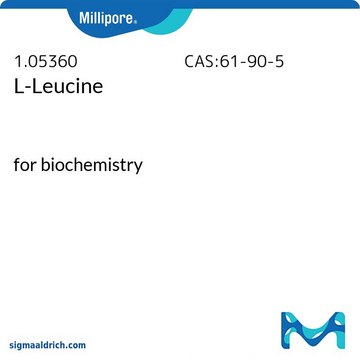Kluczowe dokumenty
L8912
L-Leucine
98.5-101.0%, suitable for cell culture, non-animal source, meets EP, JP, USP testing specifications
Synonim(y):
(S)-Leucine, (S)-2-Amino-4-methylpentanoic acid
About This Item
Polecane produkty
Nazwa produktu
L-Leucine, from non-animal source, meets EP, JP, USP testing specifications, suitable for cell culture, 98.5-101.0%
pochodzenie biologiczne
non-animal source
Poziom jakości
agency
USP/NF
meets EP testing specifications
meets JP testing specifications
meets USP testing specifications
Próba
98.5-101.0%
Formularz
powder
aktywność optyczna
[α]20/D 14.9 to 16.0°, c = 4 in 6 M HCl
[α]25/D 14.9 to 17.3 °, c = 4 in 6 M HCl
jakość
meets EP, JP, USP testing specifications
metody
cell culture | mammalian: suitable
zanieczyszczenia
endotoxin, tested
kolor
white
mp
>300 °C (lit.)
rozpuszczalność
1 M HCl: 50 mg/mL
ślady kationów
As: ≤1 ppm
Fe: ≤10 ppm
NH4+: <0.02%
heavy metals: ≤10 ppm
Zastosowanie
peptide synthesis
pharmaceutical (small molecule)
grupa funkcyjna
amine
carboxylic acid
temp. przechowywania
room temp
ciąg SMILES
CC(C)C[C@H](N)C(O)=O
InChI
1S/C6H13NO2/c1-4(2)3-5(7)6(8)9/h4-5H,3,7H2,1-2H3,(H,8,9)/t5-/m0/s1
Klucz InChI
ROHFNLRQFUQHCH-YFKPBYRVSA-N
Szukasz podobnych produktów? Odwiedź Przewodnik dotyczący porównywania produktów
Opis ogólny
Zastosowanie
- as a hypertrophic agent to monitor its effects on myotubes.
- as a component of PMG media for culturing yeast.
- in myotube protein synthesis analysis in skeletal muscle cells.
- to study its effects on hepatic lipid metabolism.
Działania biochem./fizjol.
Inne uwagi
Zastosowanie
produkt podobny
Kod klasy składowania
11 - Combustible Solids
Klasa zagrożenia wodnego (WGK)
WGK 1
Temperatura zapłonu (°F)
Not applicable
Temperatura zapłonu (°C)
Not applicable
Środki ochrony indywidualnej
Eyeshields, Gloves, type N95 (US)
Wybierz jedną z najnowszych wersji:
Masz już ten produkt?
Dokumenty związane z niedawno zakupionymi produktami zostały zamieszczone w Bibliotece dokumentów.
Klienci oglądali również te produkty
Nasz zespół naukowców ma doświadczenie we wszystkich obszarach badań, w tym w naukach przyrodniczych, materiałoznawstwie, syntezie chemicznej, chromatografii, analityce i wielu innych dziedzinach.
Skontaktuj się z zespołem ds. pomocy technicznej








